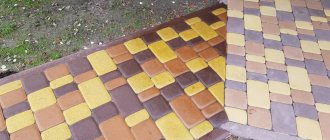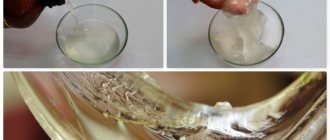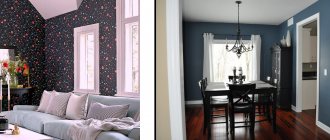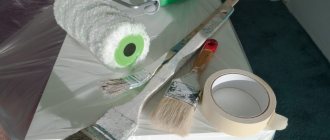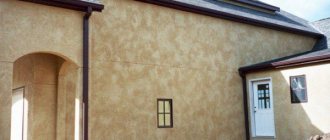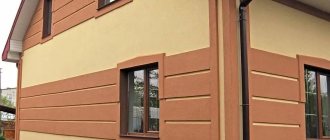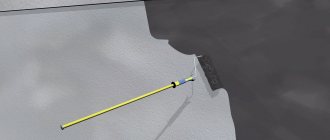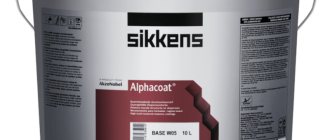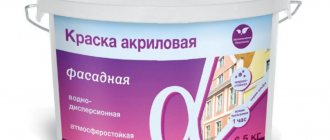Water-dispersion paint Water-dispersion paints are widely used for household purposes. They can be easily applied to almost any surface: metal, wood, concrete, brick, polymers. The water-dispersed composition is an aqueous solution, where the connecting link is aqueous dispersions of acrylic, styrene-butadiene or vinyl acetate copolymers. Acrylic materials are used in most painting works: repair and finishing of external and internal walls of residential buildings and office premises. Some paints are used in the artistic field, they are used to decorate designs on fabrics and paint. Water-dispersion acrylic paint, due to its universal properties and many advantages, has received a wide range of applications. Its advantages are:
- durability of the coating;
- quick drying, which allows you to apply the next layer after 1 hour;
- the brightness of the color is preserved and does not fade from sunlight;
- low level of toxicity;
- fire safety;
- no unpleasant odors during operation.
Paint consumption per 1 m² is one of the main indicators of coating. For acrylic water-dispersion paint, the consumption ranges from 120 to 150 g/m². This indicator may vary depending on the surface being painted, because a rough surface will require more paint. Some types of materials need to increase the consumption to 200 g/m² to give good wear-resistant qualities.
To correctly perform a preliminary paint calculation, you should multiply the consumption indicated on the packaging by 1.15. This way you will avoid the possibility of additional search for material if the volume of purchased paint is not enough. It is better to purchase it in large containers, this will minimize the cost of the material.
Before buying paint, you need to calculate its consumption
Acrylic VDK for external use
To organize work outdoors, you must wait for favorable weather conditions.
When applying a layer of acrylic VDK, it is important to follow the following rules:
- High humidity levels contribute to the destruction of the coating. After application, a protective layer will not appear, so the paint will not be able to dry completely.
- Work is not carried out in windy weather. There is a possibility of sand or small debris sticking to it.
- Exposure to direct sunlight will cause paint to set unevenly. During hot periods, it is recommended to create artificial shading. It will be easier for the master to work, defects during application can be avoided, and drips can be removed.
Acrylic paint must be applied according to the instructions.
Sequence of work:
After cleaning, the facade must be primed with a specialized deep penetration compound.
- First, remove all stains and dirt from the surface. It is recommended to use a degreaser.
- All irregularities are leveled out. You can use putty, cement-sand mortar, and plastering the walls.
- Areas with mold are treated with rags and removed with sandpaper. A fungicide is applied to problem areas.
- When painting for the first time, the walls are pre-primed with a roller or brush. The primer dries within 14 hours.
- The paint is thoroughly mixed before use. You can give the desired shade by adding color or mixing several pigments.
After hardening, the layer of material becomes durable and cannot be washed off. For personal safety, wear gloves or treat the skin with a thick cream.
Professional secrets for interior work
Interior painting of residential premises has its own nuances. When working with VDK, air humidity increases significantly. To create a safe and comfortable environment, it is advisable to install forced ventilation. At the same time, the paint and varnish material will dry faster and better.
To make the coating look perfect, use the following recommendations:
- You need to start applying paint parallel to the frame structure, from the side of the window.
- The first time it is better to paint with a brush, a composition diluted in a ratio of 0.5 liters of water to 5 liters of paint. Subsequent layers are applied with a roller to achieve a leveled surface.
- Each coat of paint is applied at intervals of 3 hours.
- The sprayer will significantly speed up painting the walls. It can be used at a distance of a meter from the windows.
- If the surface is highly absorbent, it may be necessary to apply three layers to obtain a high-quality coating.
- Before painting the interior walls, it is better to dismantle the baseboards or cover them with masking tape.
- If, according to the design plan, you need to paint one wall in two different colors, which will visually divide the room into zones, for example, for working at the computer and relaxing in front of the TV, use the same masking tape.
- Always consider the natural light factor. The final coat of paint on the ceiling will look better if applied perpendicular to the wall with the light source.
Water-dispersed paint and textured rollers with stencils will help create stylish and bright interior elements.
Paint VD AK Acrylife No. 51 for metal
PURPOSE AND APPLICATION:
Professional paint based on acrylic polymer containing active anti-corrosion pigments. Recommended for painting primed steel, aluminum, galvanized structures, machines and equipment used both indoors and in an open atmosphere in a temperate climate. The coating has excellent adhesion to any metal substrate. Drying time to degree 3, touch-free - 20 minutes. at an ambient temperature of 20ºС and a relative air humidity of no more than 65%. Full mechanical strength of the coating is achieved 12 hours after painting. Full anti-corrosion resistance is achieved 3-5 days after painting. It is not allowed to expose the painted surface to water earlier than 24 hours after painting. The surface to be painted must be covered with at least two layers of paint. The paint is fire and explosion-proof during storage and painting work.
The advantage of acrylic water-dispersed anti-corrosion materials is their fire and explosion safety during storage and painting work, as well as the fact that coatings based on them have a higher elasticity (than coatings based on organic solvent paints) and elasticity that is unchanged from aging (in the case of with metals this is very important, because they have large linear expansions due to temperature fluctuations)
In addition, acrylic water-dispersed anti-corrosion materials are non-toxic, odorless and do not require special protective measures when working with them.
The paint is available in white. Can be tinted in any colors and shades according to the catalogs NCS, RAL, Moscow Palette, Caparol, Dufa, according to the sample, etc.
SURFACE PREPARATION:
The surface to be painted must be free of rust and primed with metal primer.
COLOR:
Mix the paint thoroughly before applying. If necessary, dilute with water, but not more than 5%, do not mix with other solvents. Apply by brush, spray or roller. The surface to be painted must be dry and clean. When painting and drying, the temperature of the air and the surface to be painted should be within +(15-30) ºС, the relative humidity should be 20-60%. When painting, the temperature of the steel surface should be at least 3 °C above the air dew point. The prepared surface must be painted with 2-3 layers of paint.
Pay special attention to painting edges and corners, as this is where corrosion begins first.
CLEANING INSTRUMENTS:
After finishing work, rinse working tools with water.
Water-based acrylic paints
The use of acrylic water-dispersion paints is quite wide and varied. The modern range of water-based acrylic paints allows you to carry out almost all types of finishing work during construction and renovation.
KrasKo company
offers you high-quality acrylic-based water-based paints:
- Facade-Lux - water-based acrylic paint for the facade, base and walls.
- Proacrylic is a snow-white acrylic paint for walls and facades.
- Aquakras is an interior paint for walls and ceilings in dry rooms.
- Aquakras WR - interior paint for walls and ceilings in rooms with high humidity
- Potolox is a snow-white paint for ceilings in dry rooms.
- Potolox is a super white acrylic paint for ceilings in wet rooms.
- Stenolux is a washable wall paint with a “lotus effect”.
Painting building facades
The most common type of water-dispersion paints for finishing mineral surfaces of building facades (concrete, brick, plaster, etc.) are acrylic materials.
This type of binder is distinguished by high adhesive strength of coatings, weather resistance, water resistance, and light resistance. In addition to this, they have increased alkali resistance, which is especially important when painting concrete surfaces.
Acrylic dispersions are the highest quality type of finishing paints for building facades in large cities. These film formers form coatings that have excellent moisture resistance and dirt-repellent ability, which determines the high durability of coatings when used in a polluted urban atmosphere.
Protection of building structures
Concrete and reinforced concrete elements and structures are often operated in conditions where their surface is exposed to corrosive environments. In this case, it is appropriate to talk about the protection of concrete structures and structures from corrosion. Here it is also possible to use materials based on acrylic resins.
Finishing rooms with high humidity
For finishing rooms with high humidity (bathrooms, showers, saunas), special acrylic paints are used with the addition of antiseptics that prevent the appearance of mold and fungi on the surface of the coatings and suppress the vital activity of microorganisms.
Proacryl acrylic paint with high water-repellent properties
may be recommended for use in conditions of high humidity.
And thanks to special fungicidal additives, Proacryl
can also be used to protect against biological corrosion, especially inherent in humid environments.
Acrylic paint composition
Acrylic acts as the base in any acrylic paintwork material, but in addition to it, it necessarily contains a number of additional components.
Binders
The base, or binding mass of the paint, is polyacrylates in the form of an aqueous dispersion, which are considered film formers. They are responsible for strong adhesion of the composition to the surface and, thanks to their strength, ensure a long service life of the coating. The higher the quality of the base, the more reliable the dried film will be, the less it will react to mechanical damage.
Fillers
The carrier for the base in this coating is water, which makes an emulsion from the acrylic polymer. The paint dries due to the evaporation of water, but this process occurs too quickly, so retarders are added to paintwork materials - substances based on glycerin or glycol.
Drying retardant for acrylic paints Sonnet
In addition to acrylic copolymers, paints may contain up to 10% auxiliary monomers. The latter can significantly influence the properties of the material, adjusting them according to a specific purpose. Thanks to such fillers, you can change:
- elasticity;
- strength;
- hardness;
- chemical resistance;
- adhesion;
- colloidal stability.
Also, paints often contain natural minerals as fillers: talc, chalk, dolomite, calcite, kaolin, mica, barite and others. Efficiency is achieved by adding crystalline fillers with high reflectivity.
Ground talc for paints and enamels
Color pigments
Pigments are needed to give a specific color to paint. Usually they are a powder, less often a paste or liquid, which is added to the main composition. Pigments also increase the covering power of paintwork materials and enhance its resistance to ultraviolet radiation and other atmospheric factors.
Pigments can be organic and inorganic, synthetic and natural. Often, inexpensive weather-resistant substances are used for the acrylic composition - oxides of chromium, iron, lead, metal sulfides. Among inorganic colors, titanium dioxide is also used, which is introduced into super-white paints and has a high refractive index of light.
Organic pigments are used less frequently. They are tinting pastes of bright color, while they are more expensive, but have less resistance to weathering. Typically, pigment particles have sizes of 300–400 microns, since they optimally fill the voids between the components of the paintwork material and are evenly distributed throughout the material.
Solvents and other additives
Organic solvents are added only to special formulations, but most acrylic paints are diluted with plain water. The liquid reduces viscosity, imparts proper density and ensures ease of application. Additional substances in acrylic paints may include:
- emulsifiers;
- surfactant;
- biocides;
- defoamers;
- stabilizers;
- preservatives;
- initiators.
Auxiliary additives change the quality, technical, and functional characteristics of the paint and give it special properties. They also provide the necessary shelf life, coating service life, composition stability, and regulate the process of film formation. For example, surfactants and emulsifiers help pigments to be better distributed in the total mass and reduce the surface tension of emulsions. Preservatives inhibit the development of microbes, mold, fungi, defoamers reduce foam formation, thickeners regulate fluidity.
Mixing order
When producing paint, an acrylic copolymer is first placed in a container, pigments and a solvent (water) are poured in. Then a strictly measured amount of stabilizing and targeted additives and fillers is added. When ready, the paint is packaged in containers, but each batch is first tested for compliance with GOST or TU.
Types of acrylic paint
First of all, it is worth noting the type of painted surface - matte or glossy. The first is perfect for ceilings and facade work, and gloss looks good on the same wall.
Important! Matte paint is much more effective in painting uneven surfaces, as it can hide minor imperfections. At the same time, glossy options, due to the difference in light refraction, immediately highlight even the smallest imperfections. Therefore, the surface to be painted must be especially well leveled before work.
Also, paint can vary in type, depending on its ability to withstand moisture. Therefore, not all acrylic paints are suitable for working outside or in wet rooms, and you need to look for the right option.
Tips and tricks
In order to create a beautiful design with acrylic paints, you need to follow some guidelines. So, during the process of work, many people have a question about how to dissolve such compositions, because they are quite thick and dense. The most common solvent is water. It can be used if only because it is part of almost all acrylic paints.
But after you dilute the paint with water and mix it, a protective film will form on all tools. That is why, immediately after mixing and applying this paint to the surface, it is necessary to thoroughly rinse and clean all fixtures and tools. This must be done within an hour after completion of work.
You can also dilute paints using compounds specially designed for this. They are sold ready-made. In addition, with their help you can transform an acrylic-based composition if you do not want to buy another one or accidentally made a mistake in your choice. The thinner can make the paint glossy or, conversely, matte.
When diluting paint with water, it is necessary to maintain the correct ratio. The ideal option is dilution in proportions of one to one. Then the paint will cover walls and other surfaces without leaving gaps. It is better to use thinned paint first as a base and then apply it as a second coat.
If you want to apply a very thin layer of acrylic paint or make its shade less bright, then you need to dilute it with water in a ratio of one to two. This composition will saturate any surface well and lay down in a thin layer.
Some people also have problems with acrylic paints drying out. But to solve this problem, they only resort to diluting it with water and stirring it. It is not right. Experts recommend first turning dried mixtures into powder, grinding them using special equipment, and then pouring boiling water over the resulting powder.
After this, you need to wait until the water has cooled completely. It must be carefully drained so that the paint elements remain in the container again. Then you need to repeat this procedure. On the second lap, do not drain all the water completely. It is enough to leave about half of this composition so that there is enough water to dilute the paint to the desired consistency.
Although the composition of this paint will be similar to what it was before drying, if you carry out this procedure, its quality characteristics will become worse. With its help, it is better to paint only utility buildings and some discreet interior elements. It is not recommended to paint over an accent wall with this coating.
Experts give many recommendations regarding the process of applying paint and technology for working with acrylic compositions. Before painting walls or other surfaces with acrylic compounds, they must first be prepared. To do this, remove excess dirt and dust, clean the walls and ceilings from greasy stains and streaks.
Before using such compositions, it is necessary to level all surfaces, otherwise the paint may highlight all the imperfections. Before applying paint, it is necessary to remove all old coatings, including paintwork. For this it is better to use a high-quality spatula. Even small particles of paint remaining after cleaning can ruin the new coating.
It is better to treat cleaned surfaces with a primer before applying the composition. In this way, you can protect the walls and ceiling from bacteria and fungus and reduce the consumption of acrylic composition when painting. Acrylic paint should not be applied if the surfaces have cracks or uneven surfaces. All of them must be covered with putty.
Acrylic paints must be applied to the surface of walls and ceilings in a certain sequence. First you need to paint all the corner areas and draw clear lines along the entire perimeter of the walls and other surfaces using a roller. Then you need to paint the central part with it. You should work in the corners with a brush to paint them better.
In order for the white coating on the walls to look smooth and of high quality, you must follow one of the rules. So, the last decorative layer must be applied horizontally with a roller towards the window. When applying paint to walls, two layers are considered the minimum. But, as a rule, it is applied in three layers. This way you can achieve the brightest and most saturated color, and also cover up all the gaps.
The highest quality painting can be achieved using a spray gun. This mechanical method of painting requires certain skills.
Advantages of acrylic compositions
Water-based acrylic paint has the following advantages:
The listed qualities and advantages confidently ensured the great popularity of the material in the finishing materials market.
ON A NOTE! Today there is a large selection of compounds for various purposes on sale in different price categories. When purchasing, it is important to pay attention to the manufacturer. Domestic manufacturers whose products are represented by the following brands have proven themselves well: Expert, Raduga, GOODHIM. From foreign countries, the best water-based acrylic paint is TIKKURILA (Finland) and DULUX (Great Britain).
Disadvantages of water-dispersed coatings
With all its advantages, water-dispersion paint also has features that many would consider disadvantages:
- The material can only be stored at room temperature (0...+30 °C). When overcooled, the dispersion deteriorates.
- VDC should be applied at temperatures from +5°C and humidity up to 80%. In other conditions, the coating film will not form (in the cold it will crack, and in high humidity the paint simply will not dry).
- Undried paint should be protected from precipitation for at least a day. In the first hours after application, rain will wash it away, and in the future it will shorten the service life of the coating.
- When painting in the heat or exposed to sunlight, the dispersion dries too quickly. Stains and brush marks remain on the coating.
- Water-dispersed coatings produce a thinner film than solvent-soluble ones. Because of this, the surface for their application must be prepared more carefully.
Water-based paints are much more expensive than others, but have a number of other advantages
Advantages and disadvantages
A water-dispersible substance, which is used for painting wood, radiators, walls, and ceilings, is suitable for facade and interior work, and has many positive qualities.
For example, these:
- Complete safety and environmental friendliness. This is because plain water is used as a solvent.
- No smell.
- Easy to apply. You don't need to be an expert to coat the base. A simple roller or brush will do.
- Fire safety. These substances do not burn.
- Fungus or mold cannot develop on such a coating. Because a layer of paint gives the surface the opportunity to breathe.
- Long service life (about 15 years). In this case, the coating does not crack or swell.
- It takes two hours to dry one layer of the substance.
- High level of resistance to mechanical stress.
- Adequate cost.
- Not afraid of water. This is true for wood surfaces. The film that forms prevents water from penetrating onto the base.
- Made in accordance with certificates and requirements.
In addition to this list of advantages, such paintwork also has certain disadvantages:
- The quality of the paint layer will depend on external weather conditions. You should not paint if it is cold or raining or snowing. When it rains, the solvent will not be able to evaporate. If it is very hot, then it is also better to postpone work. Because the coating dries too quickly, and its quality will suffer.
- First you need to prepare the base well. It is important to level it, since all irregularities will be visible through the layer of coloring agent.
- The cost is sometimes higher compared to those types of paints where other types of solvents are added.
Professional secrets for interior work
Interior painting of residential premises has its own nuances. When working with VDK, air humidity increases significantly. To create a safe and comfortable environment, it is advisable to install forced ventilation. At the same time, the paint and varnish material will dry faster and better.
To make the coating look perfect, use the following recommendations:
- You need to start applying paint parallel to the frame structure, from the side of the window.
- The first time it is better to paint with a brush, a composition diluted in a ratio of 0.5 liters of water to 5 liters of paint. Subsequent layers are applied with a roller to achieve a leveled surface.
- Each coat of paint is applied at intervals of 3 hours.
- The sprayer will significantly speed up painting the walls. It can be used at a distance of a meter from the windows.
- If the surface is highly absorbent, it may be necessary to apply three layers to obtain a high-quality coating.
- Before painting the interior walls, it is better to dismantle the baseboards or cover them with masking tape.
- If, according to the design plan, you need to paint one wall in two different colors, which will visually divide the room into zones, for example, for working at the computer and relaxing in front of the TV, use the same masking tape.
- Always consider the natural light factor. The final coat of paint on the ceiling will look better if applied perpendicular to the wall with the light source.
Water-dispersed paint and textured rollers with stencils will help create stylish and bright interior elements.
Technical characteristics of acrylic compositions
Distinctive properties of the acrylic composition:
- viscosity (the mixture is distributed evenly, quickly fixed, and does not flow off the surface);
- low weight allows you to paint fragile materials (plasterboard);
- high hiding power (two layers are enough for the finishing coat).
The drying speed is affected by the air temperature and humidity in the room. Optimal indicators:
- temperature – above 15°C;
- humidity – 65%.
Advantages of the material
Painting walls with acrylic paint.
Main advantages:
- dries quickly (from 2 hours, it takes 2 days to dry completely);
- withstands washing and exposure to sunlight;
- no pungent odor;
- ease of application;
- good heat resistance (withstands temperatures down to -30°C);
- the resulting protective film prevents the appearance of cracks;
- resistance to temperature changes;
- absence of substances harmful to health;
- the ability to choose the desired color for the interior;
- long service life (at least 8 years);
- fire safety.
Disadvantages of acrylic solutions
Such negative points are important when choosing a material:
- high cost compared to other varieties;
- low vapor permeability, with a film thickness of 200 microns - about 0.0003 mg/(m*h*Pa).
The high cost is compensated by the hiding power: fewer layers are required to cover the surface.
Which facade paint is better?
Each manufacturer can produce products with improved certain properties, so the question of which façade paint is better is rather a matter of personal preference.
We will only indicate by what properties you can make your choice:
- weather resistance – limited (for interior use);
- weather resistance – full (for painting facades and external walls);
- light fastness (resistance to UV rays);
- vapor permeability – required for covering mineral facades;
- degree of adhesion (sticking) - depends not only on the composition, but also on compliance with the application technology;
- mechanical resistance - determined by the strength and degree of adhesion;
- biological stability;
- resistance to stains and washing;
- drying speed;
- hiding power;
- painting qualities;
- reflectivity;
- possibility of using colors.
Facade acrylic paint
To protect facades from external destructive influences, latex facade paint is quite actively used, which is positioned as an effective paint and varnish material, where polyacrylic polymers are used as a film-forming substance. Moreover, it is these polymers that also act as a binder, ensuring reliable adhesion to absolutely any surface. And the film-forming substance binds fillers and pigments, which are also included in acrylic facade paints. In particular, the pigment is necessary to give facade acrylic paint opacity and color, and the filler gives the paint coating certain physical properties.
Features and composition of water-dispersion paint
Paints of this type have their own characteristics, which give them different qualities and properties. What they have in common is that each type of dispersion paint is a white thick substance consisting of solid particles dissolved in the liquid component. Color is given to it using pigments, which can be added by the manufacturer, or you can do it yourself.
Water-dispersed acrylic paint is a material that contains various polymers and resins. Water plays the role of a solvent for them. This important feature makes these paints more durable and environmentally friendly; they contain no toxic volatile substances.
What's included:
- The main ingredient is a substance that forms a protective film on the surface of the coating. It ensures the durability of the coating and its quality.
- Pigments that color white acrylic composition in various shades.
- Natural or synthetic fillers (marble chips, talc, etc.). They are part of water-dispersion paint and give the compositions certain qualities.
- Other additives give paint additional properties, such as reducing drying time after application to surfaces.
Features of use
Regardless of the type of surface, the principle of using facade paint is almost identical. A big role in preparing for painting is to clean the walls of grease, accumulations of dirt or old paint. The better the surface is prepared, the more it dries, the better the paint will adhere.
For the best effect, you need to apply more than two layers, but a new layer is applied only after the previous one has completely dried. Despite the fact that acrylic coating is considered universal, the type of surface being painted and the composition of the paint are of great importance.
Since this paint has a high drying speed, during use it is better to pour it from the packaging into a small container so that it does not have time to dry. It is also advisable to carry out painting at temperatures up to +20 degrees Celsius, because high temperatures speed up drying.
Painting tools (brushes, roller) can be easily washed with water after completion of work. A roller is convenient to use when painting a large surface area, and brushes are best used for hard-to-reach places.
Wooden surfaces
To paint wooden surfaces, it is necessary to use paint containing antiseptics and fire retardants. Antiseptics prevent mold from appearing, and fire retardants protect during a fire.
The process of preparing wood before painting can be divided into several stages:
- when simple repairs are made to refresh buildings, you don’t have to remove the old layer of paint if it is completely preserved and not damaged. In other cases, the old coating, dirt and mold are completely removed;
- you need to completely dry the wood and fill up all cracks or defects;
- Apply a special primer and treat the joints with sealant. Ideally, the primer should contain an antiseptic.
The dyeing process itself takes place using a brush. It is necessary to move it in the direction of the fibers so that there are no streaks, and sand each new layer after drying. This way you can achieve a smooth finish. If you need to paint a large surface, sanding may not be necessary. The end result will still look attractive.
Metal surfaces
Due to the fact that the metal quickly reacts with moisture, the main problem of this fairly durable material is corrosion. That is why it is worth choosing paints with a high content of anti-corrosion substances, which will protect the metal from the adverse effects of weather conditions.
There are coatings that can be used even over rust and without a primer, but it is worth considering that the better the metal is prepared for painting, the longer it will last.
Brick surfaces
Painting a brick house is a little more difficult than other surfaces. First of all, it is necessary to seal all cracks with plaster or cement mortar, and then clean from dust and dirt; if there is old paint, remove it. Once the walls are clean, you can wash them with water from a hose. Sometimes damp walls are treated with a special cleaner.
After the walls have dried, you need to move on to priming, and then to the painting itself. For painting, it is better to choose a wide brush so that there are no unpainted stripes.
Plaster and concrete
Fresh and well-dried plaster is easy to paint:
- first a primer is applied;
- the surface dries well;
- then follows the application of paint.
If the surface has defects, then first of all you need to clean it, putty, sand, prime, and then paint. These processes are the same for both plaster and concrete surfaces.
To learn how to properly apply acrylic paint, watch the following video.
Purchase and storage of coverage
On the Internet, on various industrial and construction portals, you can find a lot of proposals for the implementation of acrylic VDK.
Serious companies always guarantee the quality of any paint coating, provide it with reliable storage conditions, and they usually do not have any difficulties with delivery of the goods.
The presence of water in paint components creates some restrictions on storage and transportation methods.
Containers for these purposes must be made of corrosion-resistant materials - stainless or polymer.
VDK cannot be stored at sub-zero temperatures. The permissible freezing limit is no more than 5 times. Transportation is allowed for one month at a temperature of −20 °C, if this can be controlled. This is the only minor drawback for the consumer.
New technologies for the production of acrylic water dispersions make it possible to use their unique properties to coat almost any materials and structures, increasing their resistance to fire and corrosion.
They are not inferior in quality to pentaphthalic paints for painting wooden surfaces, but they dry very quickly and do not have toxic fumes with an unpleasant odor.
This encourages buyers to choose VD-AK and forget about the usual enamels and varnishes collecting dust on the shelves.
Purchase and storage of coverage
On the Internet, on various industrial and construction portals, you can find a lot of proposals for the implementation of acrylic VDK.
Serious companies always guarantee the quality of any paint coating, provide it with reliable storage conditions, and they usually do not have any difficulties with delivery of the goods.
The presence of water in paint components creates some restrictions on storage and transportation methods.
Containers for these purposes must be made of corrosion-resistant materials - stainless or polymer.
VDK cannot be stored at sub-zero temperatures. The permissible freezing limit is no more than 5 times. Transportation is allowed for one month at a temperature of −20 °C, if this can be controlled. This is the only minor drawback for the consumer.
New technologies for the production of acrylic water dispersions make it possible to use their unique properties to coat almost any materials and structures, increasing their resistance to fire and corrosion.
They are not inferior in quality to pentaphthalic paints for painting wooden surfaces, but they dry very quickly and do not have toxic fumes with an unpleasant odor.
This encourages buyers to choose VD-AK and forget about the usual enamels and varnishes collecting dust on the shelves.
Safety and storage rules
Before starting coloring, apply protective cream to your face and hands and wear glasses. The room should be well ventilated during the painting process.
Water-dispersed acrylic paints must be stored at a temperature of 030°C. In the cold, storage of the material is allowed only for up to 1 month.
Choose paints from certified, trusted manufacturers; it is also worth checking with the seller the storage conditions of containers with the mixture, since improper storage often leads to a deterioration in the consistency of the material and its thickening. When choosing paint for a particular room, you need to rely on indicators such as temperature, humidity, light level, and the need for decorative effects.
Dyeing technology
Before you begin the painting process, you need to prepare the surface. First, we clean the walls from dirt, howls, whitewash, peeling concrete, etc. When the wall is dry, priming begins using a deep penetration acrylic primer. Primer consumption is from 100 to 150 g per m2. There is no point in skimping on primer, as it is an important factor in the quality of the paint job.
Note! It is recommended to use a primer from the same manufacturer as the paint. The primer can be applied using a sprayer or brush
If the surface is uneven, it is not advisable to use a roller. It is most convenient to work with a sprayer, but if the wind blows, the material consumption will increase
The primer can be applied using a sprayer or brush. If the surface is uneven, it is not advisable to use a roller. It is most convenient to work with a sprayer, but if the wind blows, the consumption of material will increase.
The primer dries from 30 minutes to several hours. It is recommended to prime loose surfaces twice.
When the surface is dry, we begin painting it. The paint is temperature sensitive: you cannot paint at temperatures below 5 degrees Celsius. If the temperature of the paint and varnish material is less than 20 degrees, it needs to be heated. The fact is that the consumption of cold paint becomes increased
You should also pay attention to the production date of the composition. If the paint has withstood the winter, there is a risk of it freezing
Such a composition will be unsuitable for use.
Tinting
The main color of acrylic paints is white. Therefore, most often surfaces are tinted. If we are talking about a small area and the paint consumption is no more than 10 liters, you can do the tinting yourself. To do this, you need to add dyes and mix the composition well. However, it would be more correct to carry out tinting at the paint manufacturer’s tinting station if the amount of work is significant. In this case, the same shade of the compositions in all buckets is guaranteed.
Before use, stir the paint well using a mixer. Apply the composition to the surface with a roller, brush or spray. We proceed from the same principles of using the tool depending on the type of surface that were described above.
A spray gun is the most convenient way to apply paint, especially suitable for large surfaces. To work with this device, the paint and varnish composition is diluted with water. According to manufacturers' recommendations, water should be no more than 10%. However, in reality, the sprayer will work normally if you pour at least 5 liters of water onto a bucket of paint.
The recommended number of layers is from 2 to 3. Apply each subsequent layer only after the previous one has dried.
The consumption of paint and varnish material depends on the painting method. When working with a spray gun, this figure will be approximately 400 g per m2. If you use a brush, the consumption will be less - approximately 300 g per m2.
Note! The use of acrylic compounds is pointless if the surface is constantly moistened under operating conditions. In such cases, it is better to give preference to silicate facade paint
Water-dispersed acrylic paint: technical characteristics
The “AK” marking on the paint container indicates the acrylate content. High-quality water-dispersion acrylic paint has the following characteristics:
Taking into account the operating conditions of the coating, choose the type of paint. Regardless of the type of VDK, they are commercially presented in the form of a thick paste. The concentrated composition is diluted only with water, any solvents are excluded.
It is best to buy white water-dispersion paint and add the pigment yourself to get the desired color. White acrylic paint is better in quality. Coatings made from ready-made painted compounds may be less elastic and durable.
Main types of water-dispersed paints based on bases and their characteristics
Developers annually offer dispersions with new inclusions and binding components. Relatively new proposals include some decorative emulsion and water-dispersion paints that form an unusual texture, for example, imitating stone. They are applied to any primed substrate, including wood and metal.
Modern water-based enamels are classified by type of application:
- Facade;
- Interior.
They contain common components, for example, to protect against mold and mildew, but they all differ in composition and characteristic properties. There are also latex and hammer compounds with special effects.
Developers annually offer dispersions with new inclusions and binding components.
Polyvinyl acetate
PVA-based paints are characterized by low hydrophobicity, so they should not be used in damp rooms. They are suitable for painting plastered ceilings in an apartment with a stable temperature regime. This is a budget option for cosmetic repairs.
They are suitable for painting plastered ceilings in an apartment with a stable temperature regime.
Acrylate
Dispersion paint with the addition of acrylates remains the most popular due to its optimal price-quality ratio. It is resistant to UV rays, so it is recommended for interior use even on the south side. A vapor-permeable elastic coating is also guaranteed.
The waterproof composition is easy to use, the layer does not crack even with a noticeable temperature difference. But this does not mean that you can experiment as facade coatings if the packaging says “for interior use.” The advantage is a perfectly flat surface after painting, regardless of the base material.
The waterproof composition is easy to use, the layer does not crack even with a noticeable temperature difference.
Latex or styrene butadiene
Styrene-butadiene dispersed compositions are moisture resistant, but their pigment quickly fades when exposed to sunlight. The interior is the place to be. These are latex compounds based on synthetic and organic rubber-type resins that look great after drying.
Application - bathrooms, bathtubs and showers, as they perfectly resist dampness and are easy to clean. You can paint insulated attics, basements and wine cellars. The walls of glazed loggias and balconies are quite acceptable, provided that a dim shade is used (the polymer quickly fades in the sun).
Application - bathrooms, bathtubs and showers, as they perfectly resist dampness and are easy to clean.
Silicone
If we talk about what silicone water-dispersion paint means, then it is worth focusing on its specialization. Known to specialists as a façade dye of excellent quality. These mixtures are distinguished by their ability to repel dirt and water, cleaning the wall during rains. Therefore, the building near the road will remain clean even in bad weather.
The coating will protect the walls from any influences, while maintaining high aesthetics and uniform processing. With this composition, specialists work on basement and facade surfaces - brick, concrete and plaster. It is noteworthy that matte and glossy variations are offered for facade work.
The coating will protect the walls from any influences, while maintaining high aesthetics and uniform processing.
How to apply water-dispersion paint to the ceiling, facade, walls
We have prepared some practical tips for applying the material to walls and step-by-step instructions. After reading it, you can get to work, and for clarity, you can watch a video on how to paint a surface
- mix the mixture thoroughly;
- if the surface is being painted for the first time, apply a primer and wait two hours;
- To obtain the desired shade, pigment is added to white paint. It is moistened in water before mixing;
- The first layer of water-dispersion paint should be applied from the side of the window, parallel to it;
- Apply one to three coats using a roller, brush or spray. The interval between layers is 4 hours. The number of layers depends on the quality of the surface being treated;
- the consumption of water-dispersion paint is approximately 140-180 g/m2.
Attention! The very first layer can be applied with a brush in the ratio of half a liter of water per five kilograms of water-dispersion paint. The second layer will be smoother if you paint it with a roller.

